#Poison path
Text

Antique Georgian mourning rings (1714-1830s).
4K notes
·
View notes
Text

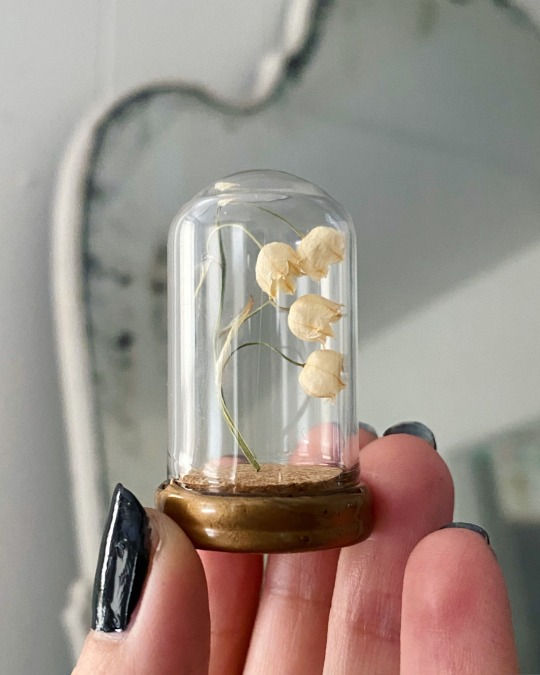
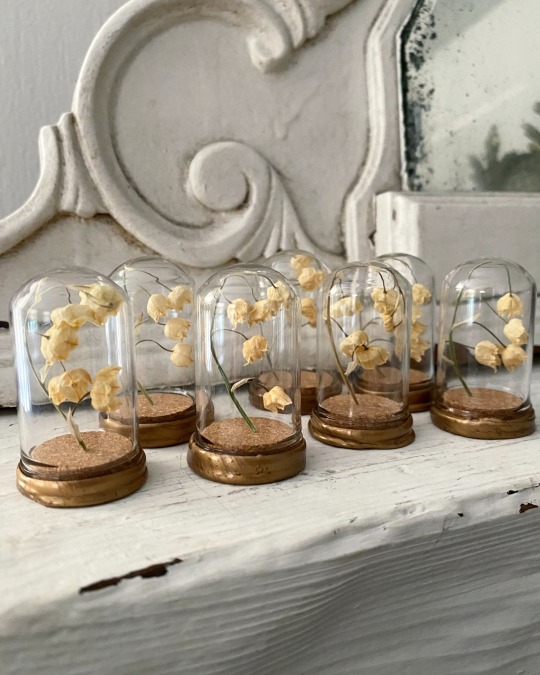

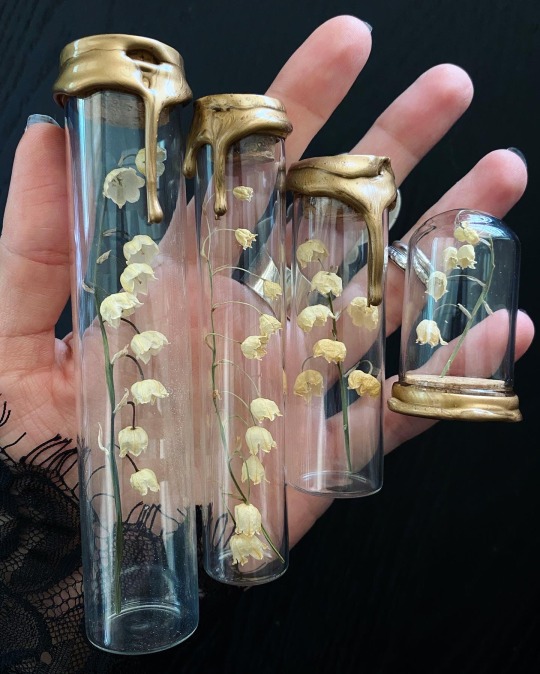
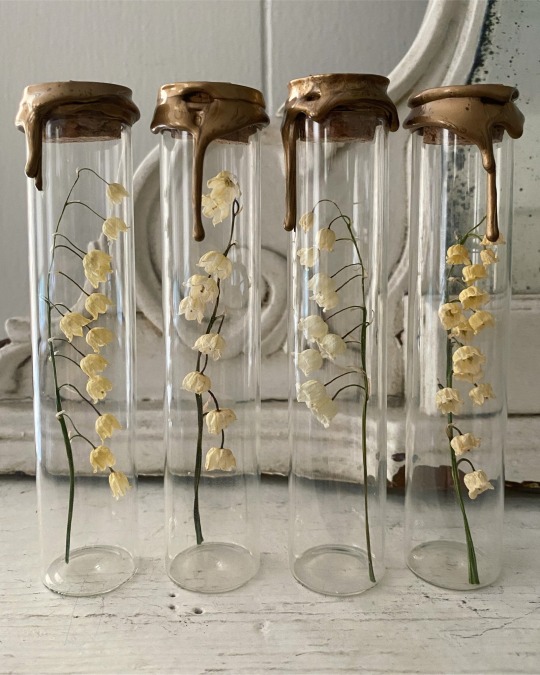
Lily of the Valley Vials and Domes. My odes to my favorite flower. 🖤
#soliloquyjewelry#soliloquy jewelry#lily of the valley#convallaria majalis#muguet#dried flowers#poisonous plants#poison path#witchcore#witchy#fairycore#cottagecore#dark cottagecore#witch cottage#cottage witch#fairy decor#wax seal
232 notes
·
View notes
Text


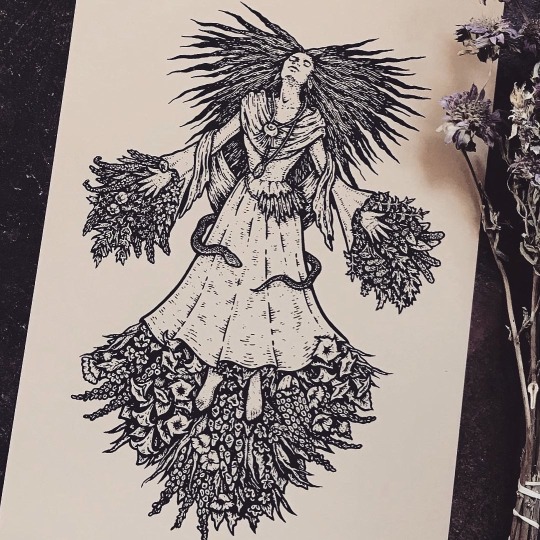


A handful of prints that are being retired! Once they’re gone, they’ll live out their days in the printshop archives.
Artwork by Poison Apple Printshop
#poisonappleprintshop#witchcraft#witch#art#occult#poison path#magic#hedge witch#herbalism#poisonous plants#Hecate#hekate
275 notes
·
View notes
Note
ok this is prolly a Dumbass question. but a lot of witchcraft ppl seem to use plants like datura, belladona, aconite, for their psychoactive properties in witchcraft- Are there any witchcraft people that just skip the whole plant foraging/gardening/obtaining bit and decide to just do shrooms or acid, or benadryl/dph i guess if one happens to just like deleriants? dph is rlly bad for health (is so bad) but tbh so is datura,.. though dph you can usually get at a convenince store. Or is it not considered spiritual if it’s a synthetic?
(I dont mean this to be offensive btw i think occult things r cool and im faded than a hoe rn. Coolio blog)
I'm sure there are practitioners who attempt to undergo Poison Path work using only synthetic drugs, but I don't really know anything about that, and so I can't speak to it very well.
I do, however, believe that working with the spirits of plants is at least as important to the process of such work as the psychoactive effects. I can grasp working with the spirit of Belladonna, but I have a much harder time envisioning myself trying to work with the spirit of a drugstore antihistamine. I also believe it's meaningful that many entheogenic plants (such as ones you listed here, including Psilocybin Mushrooms) have a longstanding traditional record of religious/cultic usage by initiated masters in their respective cultures. For these reasons, among others, I would not consider using synthetic, storebought drugs.
I also think there is a big difference between someone who messes around with party drugs and likes the idea of trying to get a bit spiritual with it, and someone who conscientiously dedicates themselves to Poison Path work. Altered brain chemistry can help the mind to see past certain filters and preconceptions, and it can also help one to look inward, but if there isn't a thoughtful, purposeful, and spiritual framework behind using an entheogenic substance, then it seems likely that it's mostly about getting high.
Finally, I want to add that, while substances such as datura are definitely dangerous, they are often used with far more reverence, caution, and frugality when approached by a serious practitioner. My husband is Oathbound to the Tutelary Spirit of Datura, but only once, under extraordinary circumstances, has that included using the plant entheogenically. He undertook the ritual with fearful respect and the utmost care, and it was an extremely meaningful experience for him, but it's not one he's likely to undertake again anytime soon. As he puts it, "She is a harsh teacher." I think part of the reason so many of these plants (particularly poisonous varieties of Ranunculaceae and Solanacea) are as harsh as they are is because they demand commitment and humility (along with self-defense, of course), which is why you pretty much hear only horror stories from most folks who attempt to use such substances lightly.
#anonymous#ask#poison path#entheogens#drugs#witchcraft#traditional withcraft#magic#spirit flight#flying ointment#Datura#Belladonna#Aconite
80 notes
·
View notes
Text


She bloomed tonight! So proud of her!!
90 notes
·
View notes
Text
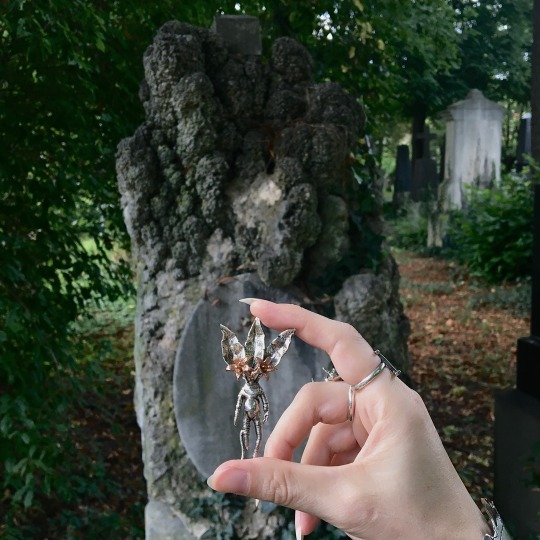
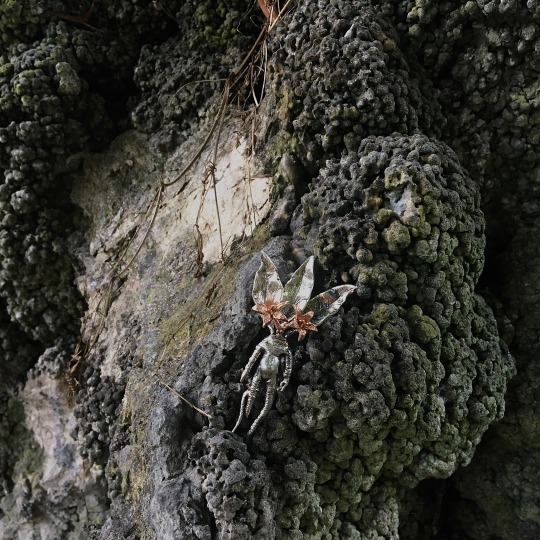
Mandragora, silver mandrake jewelry ("with flowers" version) hand carved by Moon and Serpent Website or Etsy
For more, please follow my Tumblr or Instagram
#moon and serpent#artists on tumblr#handmade jewelry#botanical jewelry#witch jewelry#poisonous plants#mandrake root#mandragora#poisonous#poison path#poisonous flowers#witchcraft#witch aesthetic#gothic aesthetic#paganism#fantasy art#faerie
84 notes
·
View notes
Text

She is blossoming 🌙🤍
#datura#stramonium#poison path#green witch#witchcraft#folk witch#traditional witchcraft#herbal magic#magical herbalism#herbalism
359 notes
·
View notes
Text
The most delightful part of starting a poison garden has been learning that Atropa belladonna is basically just a tomato for garden care purposes.
#NOT FOR EATING PURPOSES#but the care instructions are basically a more shade tolerant tomato#and i am amused#atropa belladonna#belladonna#poison garden#poison path#garden#garden witch#garden witchery#green witchcraft#green witch#slow living#slow life#cottagecore#hobbitcore
92 notes
·
View notes
Text
𓋼𓍊𓋼𓍊Wild Plant Lore P.2 𓍊𓋼𓍊𓋼
Some more notes from my herbology journal of wild plants and weeds that you can utilize in your practice. Includes mundane uses like culinary, medicinal properties, folklore/cultural importance, and magical associations. This post does contain poisonous/toxic plants that can be fatal if ingested, I'm not suggesting anyone inexperienced or experienced do anything with them, do your own research on how to handle them if you plan on using them in any way. They're interesting to learn about nevertheless.
Disclaimer at the end !!
𓍊𓋼𓍊𓋼𓍊𓋼𓍊𓋼𓍊𓋼𓍊𓋼𓍊𓋼𓍊𓋼𓍊𓋼𓍊𓋼𓍊𓋼𓍊𓋼𓍊𓋼𓍊𓋼𓍊𓋼𓍊𓋼𓍊𓋼𓍊𓋼𓍊𓋼𓍊𓋼
Yarrow- Also known as common yarrow, bloodwort, herba militaris, or Achillea Millefolium. Yarrow is a woody plant with small, round, white flowers and frilly, feather-like leaves surrounding the stems. This plant looks very similar to hemlock which is very poisonous but you can tell the difference by yarrow’s distinctive leaves. Yarrow is edible and can be eaten raw, it tastes pretty bitty and earthy so it’s best to pick while young. It’s most commonly used in salads and soups. Yarrow has a rich medicinal and magical history. It used to be called herba militaris, the military herb, because of its astringent properties. Its Latin name, Achillea Millefolium, comes from the Iliad where Achilles and his soldiers use yarrow during battle. Poultices and ointments made from its leaves are used to aid in lessening swelling and bleeding. Do not consume yarrow if you are on blood thinners or pregnant/lactating, this plant has a chance of causing miscarriages. People are commonly allergic to this plant so please be wary of this and test it before consuming, skin allergic reactions are the most common. Yarrow is also commonly used to treat stomach ailments like constipation, nausea, diarrhea, and IBS symptoms. The plant contains flavonoids that increase saliva and stomach acid to help improve digestion. It's also been used for menstrual pains and stomach aches as it can help relax the uterus and intestinal muscles. Some Native American nations have used yarrow for toothaches, earaches, and eyewashes through poultices and liquid infusions. There's no end to the magic of yarrow, there are so many different charms, divinatory practices, and spells that use yarrow in cultures worldwide. Many cultures have used it to keep away curses and evil magic, they would place it on their doorsteps to ward off evil spirits and keep witches away, or in cribs to protect babies and mothers. “When going on a journey, pull ten stalks of yarrow, keep nine, and throw the tenth away (as a spirit’s tithe), put the nine under the right heel, and evil spirits will have no power over you”.
It’s often been used in divination and psychic senses. In Ireland, it’s thought to be able to give someone ‘the second sense’ and it’s used in a lot of divinatory prayers and charms, usually to do with finding love. It’s also sometimes said that standing on the plant would give one temporary fluency of speech. There is a ceremony of some Gaelic speakers where they had to recite an incantation (the one below this block of text) before harvesting the plant as it was held to high importance. In Chinese belief, it’s thought to bring good luck and the dried stalks are sometimes used in I Ching divination.
“I will pluck the yarrow fair
That more benign will be my face,
That more warm shall be my lips,
That more chaste shall be my speech,
Be my speech the beams of the sun,
Be my lips the sap of the strawberry.
May I be an isle in the sea,
May I be a hill on the shore,
May I be a star in the waning of the moon,
May I be a staff to the weak.
Wound can I every man,
Wound can no man me.”
It’s widely used in love divination, sometimes people would put it under their pillows at night and say the rhyme below before bed. Sometimes they would pick yarrow from a young man's grave and whoever the girl saw in her dream would be hers. In some beliefs, if the man was turned to her then they’d never marry.
“Yarrow, yarrow, yarrow,
I bid thee good morrow,
And tell me before tomorrow,
Who my true love shall be.”
Girls in Aberdeen would go out in fields on a May morning to pick yarrow while reciting the chant below with their eyes closed, then open their eyes and the first man she spied would be hers that year. There are a lot of little incantations and charms like this for yarrow you can find online if you’re curious !!
“Good morrow, good morrow,
To thee, braw yarrow,
And thrice good morrow to thee;
I pray thee tell me today or tomorrow
Who is my true love to be.”
Alternatively, in some European beliefs, it was thought to be associated with the devil, being called devil’s nettle or “bad man’s plaything” due to the belief that witches used it in divination and devil worship. Elspeth Reoch was accused of being a witch in 1616 because she was caught picking supposed yarrow. In Wales, it was considered extremely unlucky to bring into the home and even supposedly called the “death flower” in some places.
⛧ Divination, love, protection from curses, witchcraft, and spirits. But also bad luck, curses, and death in some cultures
Datura- Also called devil’s trumpets, jimsonweed, and devil’s snare. Datura is a genus of 9 species, all of which are poisonous. Datura is a large, branchy herb that forms bushes. It has light green or reddish stems with long, toothed leaves and white or light violet, trumpet-shaped flowers. While the plant may look pretty but it’s very toxic and can be deadly. All parts of the plant are inedible and if ingested it causes a hefty amount of psychoactive and deliriant symptoms like erratic behaviour, hallucinations, tachycardia, heat flashes/hyperthermia, and a variety of other not-so-pleasant symptoms including death. While this plant is psychoactive it’s not a good idea to try to use it recreationally as the symptoms can last up to two days with reports of it lasting for as long as 2 weeks. There have been multiple reports of deaths from people attempting to get a high out of datura and even when “successful” the majority of people report having extremely unpleasant experiences. Datura is also often called Jimsonweed which comes from another name, Jamestown weed, which refers to when English soldiers were attempting to suppress Bacon’s rebellion in Jamestown and consumed boiled datura which left them in altered mental states and ill for 11 days. Because of how dangerous this plant is, there aren’t any real suggested medicinal uses for it. Datura has been used in many cultures for ritual and ceremonial practices due to its psychoactive effects. Many Native American nations used it in very specific ways to aid in their ceremonial practices alongside other sacred herbs. The name datura is taken from the Hindi word धतूरा, dhatūra, meaning thorn apple (in reference to Datura metel, a datura species native to Asia). Datura plays a role in Hinduism as datura is considered a favourite plant of Shiva. Datura also has a long history in witchcraft and the occult, it’s long been associated with witches and magic due to its psychoactive effects. Throughout many cultures, its been used to help connect with deities and spirits, aid in necromancy, healing rituals, and used in flying ointments and curses. In modern-day practice, datura is still fairly commonly used to promote psychic powers and aid in visions, astral projection, divination, and spirit communication. Additionally, likely due to its history of being used as a poison, it’s often used in curses.
⛧ Psychic senses, spirit communication, astral projection, curses
Lily of The Valley- Also known as glovewort, May bells, Our Lady’s Tears, and Convallaria majalis. Lily of the Valley is a flowering plant made up of one thin stalk that has two thick, long, swirling leaves. The downturned white, bell-shaped flowers droop to one side and are often accompanied by small red berries. These plants are often found in woodland areas and bloom in the Spring. Lily of the Valley is not edible and if ingested can be fatal. The entire plant is poisonous and can cause irregular heartbeats, nausea, vomiting, and abdominal pain if consumed. If touched, it can cause dermatitis and skin reactions so always wash your hands after handling it or use gloves. Despite that, the plant has been used in a lot of folk medicines. It’s often called glovewort in Europe as it was used in salves for sore hands and oils from the rhizome were used to promote heart health. There have been no studies done to verify its effectiveness and it’s often unsafe to consume and touch so it’s not recommended to try to use it medicinally. Although it’s poisonous, it has a very strong and sweet-smelling fragrance that many perfumes have recreated. Lilies of the Valley are often seen at weddings, celebrations, and sometimes funerals. In the Language of Flowers, Lily of the Valley signifies the return of happiness, likely originating from its place as the flower of Spring and May. On May 1st, May Day or Lily of the Valley Day is celebrated by giving the flowers to loved ones to bring happiness and luck. It’s sometimes called Apollinaris from the Greek myth that Apollo made paths of it on Mount Parnassus so his 9 nymph muses could walk through the forests unharmed. In Christianity, it’s sometimes referred to as Our Lady’s Tears or Mary’s Tears from the story saying that as Mary wept at the foot of the cross after Jesus’s crucifixion, these flowers popped up wherever her tears fell. Because of this, it’s often associated with Easter and motherhood. In Romanian culture, it also represents tears with a similar story of a girl crying at the grave of her parents and her tears causing the flowers to sprout wherever the tears fell. Unfortunately, I couldn’t find much about this story beyond a brief mention though. Because of the bell shape of the flowers, there are stories of faeries ringing the bells, drinking out of them like cups, and being attracted to gardens where they grow. Lily of the Valley can be used to promote happiness, help calm the mind, and attract fae. Additionally, the poisonous berries and flowers are sometimes used in baneful and protective spellwork to stop harassment (calm chaos/harm) and protect against spells and malicious entities.
⛧ Happiness, love, motherhood, purity/humility, Spring, prosperity, faeries. Grief, death, and baneful protection in some beliefs
Mugwort- Also known as common mugwort, mother of all herbs, the witch’s herb, and Artemisia vulgaris. This is a very common flowering plant that’s a part of the daisy family. Mugwort can oftentimes be found in the wild, it has leaves that are hairless and green on top, silvery-white on the bottom, with pointed tips and purple stems. Mugwort can often be mistaken for Ragweed or Wormwood but the best way to tell them apart is that Mugwort has leaves that are hairless on top with silvery fibers on the bottom. It’s very aromatic and smells a bit like sage and rosemary. Mugwort’s leaves, young shoots, and roots are edible, though avoid consuming it in large amounts as it can be poisonous and it’s not safe to consume if you are pregnant (can restart the menstrual cycle and cause miscarriage) or on blood thinners so please talk to a doctor before using. It has a slightly bitter and floral taste, the young shoots and leaves can be cooked, and the leaves and roots can be dried and made into tea. Commonly used with meats, soups, or teas. Historically, this plant has been used for centuries for its medicinal properties with many uses to soothe stomach and digestion issues like constipation, diarrhea, nausea, and cramping. It was held so important that it was given the name mother of herbs. Huge warning for this plant though, there is a high chance that you could be allergic to it or for it to cause negative side effects like allergic reactions, nausea, shaking, hallucinations, dizziness, and seizures. This is a plant that you need to take caution around and do your own research for, as beneficial as it can be, it can be just as harmful. Avoid heavily concentrated oils of mugwort too as they may include high levels of thujone which can cause seizures, the raw plant contains little enough for this to be considered a safe plant to generally consume, this can also be absorbed through the skin. In many cultures, the plant is smoked or drank in teas. Essential oils of mugwort have also been used in insect repellents and traditionally root tinctures have been used for anxiety, irregular menstrual cycles, menopause symptoms, aid in childbirth, seizures, and epilepsy.
Mugwort is a pretty prominent plant in many cultures around the world and is very commonly used in magic. Its botanical Latin name is Artemisia Vulgaris, Artemisia comes from the goddess Artemis who is a god associated with the moon, motherhood, and childbirth which ties into the lore of mugwort. Mugwort teas are often used to promote lucid dreaming, astral projection, and heightened intuition. It’s commonly used in flying ointments, psychic teas, and incense. Mugwort also offers some protection against evil and illness, St. John the Baptist was said to carry springs with him to ward off evil and before that. In many European cultures there are Midsummer rituals where it was thrown into fires to offer protection to ward off witches, evil spirits, and illness. In a lot of cultures, mugwort is used to open the doors between the spirit realm and ours, many people use it for prophetic dreams or to connect with ancestors. Sprigs of mugwort were placed over doorways to keep away evil spirits and illness and satchels of the herb are commonly placed near beds or under pillows to induce lucid dreaming, prophetic dreams, and astral projection. In modern practice, it’s very commonly used to promote lucid dreams and astral projection by drinking it in teas or lighting incense. As well as used to aid in divination and spirit communication. Truly the witch’s herb :)
⛧ Lucid dreaming, astral work, clairsenses/psychic work, lunar associated, motherhood/womanhood, divination, ancestor/spirit work, protection from bad health, evil spirits, and nightmares
Purslane- also called pigweed, hogweed, and Portulaca oleracea. Purslane resembles a jade plant with a thick, succulent red stem and smooth succulent leaves. It’s a very low-growing plant that tends to spread outward from its center. Purslane’s leaves, stems, and flowers are edible. It tastes tart and slightly salty, similar to spinach or watercress. You shouldn’t consume it if you are prone to kidney or urinary tract stones as it contains oxalic acid. Purslane is often used in salads, soups, smoothies, and commonly even omelets. It’s considered to be a superfood but that’s generally an arbitrary term, it is a very nutritious plant nevertheless as it contains a lot of antioxidants and Omega 3 acids. Purslane is used medicinally on small wounds and burns to aid in wound health. It’s used in skincare for its anti-inflammatory properties and to reduce the visibility of wrinkles and scars. Purslane may have a cooling effect so people have used it for fevers. There are a lot of different medical uses attributed to purslane but not much scientific proof validating the claims so I won’t really go into those very much but it was often used to cure toothaches and soothe the kidneys and liver, some would call it a cure-all plant. Some will use it to help with their diabetes as it may help reduce blood pressure. Purslane was used widely as a medicinal herb and was thought to drive away illness if worn. It was considered a protective herb in many cultures, many would place it around their homes, beds, and under pillows to ward against illness, evil spirits, and magic. When researching purslane I found a lot of mentions of an old German herbal book from 1715 by Axtelmeier that said
“Even though purslane is cold and moist, it is a real summer plant and does not like the cold. There is a saying that in marriage it is always good when two different temperaments join together. The good Lord alone knows what is best and for that reason sometimes two very different personalities join together in marriage”.
I couldn’t find for the life of me the actual work it was from but there are many mentions of this passage online. There are also some references to people having worn purslane to protect themselves from gunshots, lightning, and illness. Purslane is also said to help aid in clairvoyance, scrying, and astral projection, perhaps because of its association with the moon.
⛧ Harmony, marriage, clairvoyance, astral projection, protection from spirits, illness, and harm
St. John’s Wort- Also known as perforate St. John’s wort (SJW) and Hypericum perforatum, not to be confused with mugwort. A woody flowering shrub with bright yellow, five-petalled leaves, each with a small black dot on the edge that can be seen when held up to light. It has dark green leaves which also often have those same small black, although sometimes transparent, dots. While SJW is not really regarded as being poisonous, it’s not ingestible so it’s not recommended to eat it. It’s not technically edible or not edible, the flowers and fruit are used medicinally but that’s usually the extent of consumption. If you do eat it, you may experience an upset stomach, headaches, confusion, trouble sleeping, fatigue, dizziness, sensitivity to sunlight, and increased anxiety. There aren’t many culinary uses for it, most of this will be about its medicinal uses. SJW has been used medicinally for a very, very long time, both in historical and modern-day use. This plant is usually consumed through teas, liquid extracts, and (more recently) pills made from the flowers. It’s said to taste slightly bitter but similar to black tea though is often times paired with other herbs. Historically, the Greeks used to use it to aid in wound healing, treat anxiety and aid in sleep. Some Native American nations also used it for wound healing, it has some antibacterial, antiviral, and anti-inflammatory properties which make it good to treat minor burns, abrasions, and bruises, this is usually done through the use of an infused oil. In Europe, it was also used to treat minor wounds and burns along with lung and kidney ailments and to treat anxiety and depression. SJW has been used to help with anxiety and depression in many different cultures and more recently there have been studies done to prove that it can help, in fact, it’s been shown to be as effective as some common antidepressants for mild and severe depression. It’s also still commonly used as a sleep aid. Do not take SJW if you’re on medications treating HIV/AIDS, or pregnant as it can very likely cause a miscarriage.
In Europe, where it originates, it was used often for its protective properties — people would hang it over their doorways to ward off demons, faeries, evil spirits, and even storms. Some would wear SJW to keep away witches and witchcraft and it was said to offer the most protection if it was accidentally found. The Greeks also used SJW to exorcise evil spirits and energies. It was heavily believed to offer good health and protection from death, making it quite the protective herb. Though, there is a story saying that if you step on the plant after dark a phantom horse/faery would kidnap you and drop you off somewhere far from where you started. During Christian Europe, it was associated with St. John the Baptist because it bloomed around when his canonical birthday was, it was also used to celebrate the Summer Solstice around the same time. Some Christians believed that the spots on the plant only appeared after the beheading of the Saint and that it represents his blood. Many would also put SJW under their pillow as they slept as they believed that the Saint would come to them in their dreams and offer them blessings and protection. In a German poem, there is a story of a young girl using this plant to divine who she will marry, its association with divination/fortune telling is a very common one being found in a lot of European folklore where people ask how long they’ll live or who they’ll marry. This was usually done by asking a question, leaving it hanging from the rafters overnight, and if it was wilted it would be a negative outcome. Modernly, SJW is still widely in use for very similar things like protection, healing, and divination.
⛧ Happiness, tranquility, Solar associated, protection from witchcraft, spirits, and storms, warding off evil spirits, fae, and negative energies
Wood Sorrel- Wood sorrels are members of the Oxalis genus, many being known by the common name wood sorrel. They’re characterized by 3 leaflets very similar to shamrocks and flowers with 5 petals that are typically either yellow, white, pink, or red. Some varieties have 4 leaves or purple leaves. The fruit is a small capsule that holds seeds that ‘explode’ to disperse them. They look very similar to creeping buttercups and sometimes can be mistaken as clover. Wood sorrel has been eaten by many people throughout history, they taste slightly like lemons and are sour, causing it to sometimes be referred to as sourgrass. If you like the taste you can dry and boil the leaves to make a lemony tea or add them fresh to salads. The juices of the plant have sometimes been used as a vinegar substitute or aid in curdling milk.
The name Oxalis comes from the Greek word oxús meaning sharp or pungent, referring to the sour taste. All members of the Oxalis genus contain oxalic acid, named after the genus, which gives the leaves that bitter taste. While safe to consume, in large doses it can be dangerous and cause skin and stomach irritation. With prolonged skin exposure, it can cause skin irritation and eye damage if in contact. With very large doses, it can be slightly toxic and interfere with proper digestion and kidney functions, and inhibit calcium absorption. So, Oxalis is safe for the most part but should be avoided if you have kidney diseases or are pregnant.
Oxalis has been used medicinally for a long time. It contains a lot of Vitamin C so it was sometimes used to treat scurvy. It’s been chewed to alleviate thirst and mouth sores. It has cooling properties and has been used in teas to drive away fevers and heat flashes, and help with sore throats and mouth sores. The juice can be gargled to rid mouth ulcers and applied in a compress or poultice to stop bleeding (coagulant) and reduce inflammation and swelling.
“In Dr. James Duke's Handbook of Edible Weeds, he notes that the Native American Kiowa people chewed wood sorrel to alleviate thirst on long trips, the Potawatomi cooked it with sugar to make a dessert, the Algonquin considered it an aphrodisiac, the Cherokee ate wood sorrel to alleviate mouth sores and a sore throat, and the Iroquois ate wood sorrel to help with cramps, fever and nausea.”
It’s obvious that wood sorrel looks very similar to a shamrock, so much so that it’s been argued that the shamrock might have originally been a species of Oxalis. Likely because of the resemblance, they’re often associated with luck and used in similar ways as clover. It also has 3 leaflets, 3 is a very symbolic number to many that represents past, present and future; upper, middle, and lower realms/worlds; and (re)birth, life, and death — similar to the symbolism of clover/shamrock. It’s also sometimes used as a protective plant similar to how lemon and vinegar are, making it useful in cleansing and banishing. In the Language of Flowers, it represents joy and happiness.
⛧ Joy, happiness, luck, cleansing/banishing, protection from negative spirits
Wormwood- Also called absinthe, common wormwood, and Artemisia absinthium. Wormwood is technically edible but it’s not something you can just pick and eat, natural wormwood contains thujone which can be toxic in large doses and could cause seizures. It’s also incredibly bitter so you probably wouldn’t want to eat it to begin with. Thujone is considered dangerous by the FDA but there are a lot of thujone-free wormwood products that you can purchase online. The main use of wormwood is its part in making absinthe which is an alcohol made from several different plants, another mundane use is repelling bugs.
In 1905, a French man by the name of Jean Lanfray killed his pregnant wife and two children while drunk on absinthe, this only added to the fear surrounding absinthe at the time and people began to believe that absinthe caused extreme violence, hallucinations, and death. Researchers started to experiment with wormwood and thujone in extremely large doses on animals and found it can cause seizures, hallucinations, paralysis, and death. A petition by the Croix Bleue in 1907 was signed by over 400,000 people:
“Absinthe makes you crazy and criminal, provokes epilepsy and tuberculosis, and has killed thousands of French people. It makes a ferocious beast of man, a martyr of woman, and a degenerate of the infant, it disorganizes and ruins the family and menaces the future of the country”
This caused absinthe to be banned in several European countries and the US around 1912. We now know that these reactions were caused by the alcohol in the absinthe and that the thujone in wormwood has very little effect unless taken in drastic doses. Absinthe was legalized in 2007 as long as it was thujone free. Wormwood is used in a lot of medicinal ways too, it’s important to note here that the amount of thujone in wormwood teas and medicinal infusions/pills is insignificant to the amount that is in distilled wormwood like alcohols (absinthe) and essential oils. Teas and medicinal methods that contain wormwood are safe as long as they are used properly. Wormwood is commonly used as a dewormer, hence the name, and has been proven to treat parasitic worm infections in animals just as well as commercial medicines. Wormwood is good to help with digestion issues like heartburn, stomach pain, constipation, and diarrhea – many people use it to help deal with symptoms of Crohn’s disease. Some studies have also shown that wormwood can help reduce pain and inflammation, some have used it to help treat their arthritis and joint pain. You can buy wormwood extracts and capsules online, though keep in mind that it’s not intended for extended use. Do not take wormwood if you are pregnant, it can cause a miscarriage, and do not consume if you have kidney issues because there is a chance it can cause abnormal liver function if taken too much or often.
Wormwood has a lot of magical uses both traditional and modernly. Like yarrow, it’s been used for love divination/magic —
“On St. Luke’s Day, take marigold flowers, a sprig of marjoram, thyme, and a little Wormwood; dry them before a fire, rub them to powder; then sift it through a fine piece of lawn, and simmer it over a slow fire, adding a small quantity of virgin honey, and vinegar. Anoint yourself with this when you go to bed, saying the following lines three times, and you will dream of your partner ‘that is to be’ St. Luke, “St. Luke, be kind to me, In dreams let me my true-love see.””
There is also a Bible passage that references wormwood as a star that taints the water and kills thousands of men, this is symbolic and in reference to how bitter the plant is. There are some Slavic folktales about carrying a sprig of wormwood with you to ward away evil spirits. It was said that if you burned it in a graveyard, the dead would rise and speak. It was burned with sandalwood to aid in summoning spirits. In modern-day practice, wormwood is drunk in teas and put under pillows to promote lucid dreaming and astral projection or to help aid in strengthening their psychic abilities and divination. Many use it to help ward off spirits as well as to communicate with them.
⛧ Astral projection, lucid dreaming, divination, psychic abilities, protection from spirits, protection while traveling, spirit communication
𓍊𓋼𓍊𓋼𓍊𓋼𓍊𓋼𓍊𓋼𓍊𓋼𓍊𓋼𓍊𓋼𓍊𓋼𓍊𓋼𓍊𓋼𓍊𓋼𓍊𓋼𓍊𓋼𓍊𓋼𓍊𓋼𓍊𓋼𓍊𓋼𓍊𓋼𓍊𓋼
Disclaimer !!: Before you consume or use a plant medicinally, make sure you are 100% sure on the ID. Speak with a doctor before using a plant medicinally, especially if you’re pregnant, and make sure you aren’t allergic and that it won’t interact with any of your medications. Do not substitute legitimate medications with herbal remedies, this is not medical advice. Always do your own research before consuming or using a plant medicinally. Some of the plants, while generally safe for humans, are not safe for animals and children. Make sure to avoid areas treated with pesticides and always wash your takings before use. And make sure you're never over-harvesting, always make sure there's another patch nearby (unless invasive) !!
#witchblr#witchcraft#occult#magick#correspondences#herbology#green witchcraft#kitchen magick#herbalism#wildcrafting#grimoire#book of shadows#poison path#noctifer-og#yarrow#mugwort#wormwood#datura#st. john's wort#purslane#lily of the valley#wood sorrel
52 notes
·
View notes
Text
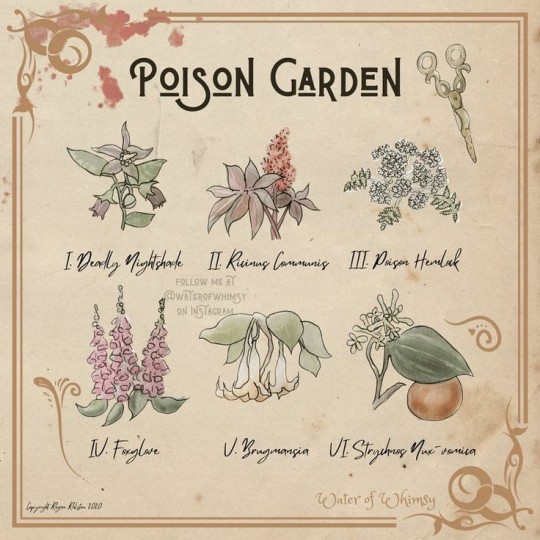
#cozycore#gardencore#grandma aesthetic#plants#cottage life#cottagecharm#cottagestyle#countrycore#warmcore#cottage garden#poison path#poisonous#plantbased#plant aesthetic#plantcore#plantblr#plants and herbs#naturism#nature witch#nature core#nature aesthetic#green aesthetic#flower fields#floral#flower aesthetic#viral photo#witchcore#witchblr#witch aesthetic#death aesthetic
153 notes
·
View notes
Text
Wild rabbits eat belladonna on purpose as self-defense to poison predators. Wild rabbits who live in the same areas as belladonna’s natural growing range are immune to belladonna’s deadly alkaloids because they produce an enzyme called atropinesterase that breaks down the atropine in the belladonna they ingest. The darker the rabbit’s fur, the more poisonous it may be.
Source
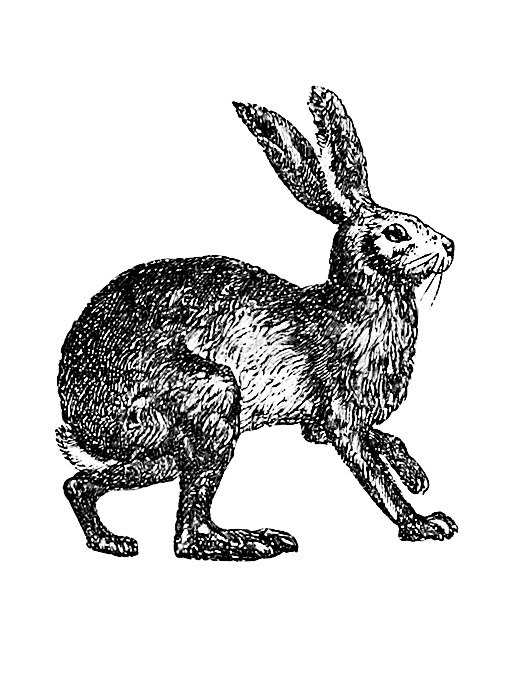

1K notes
·
View notes
Text
*squeals in witch*
Look at this GORGEOUS Hellebore I picked up while we were out and about today 😍
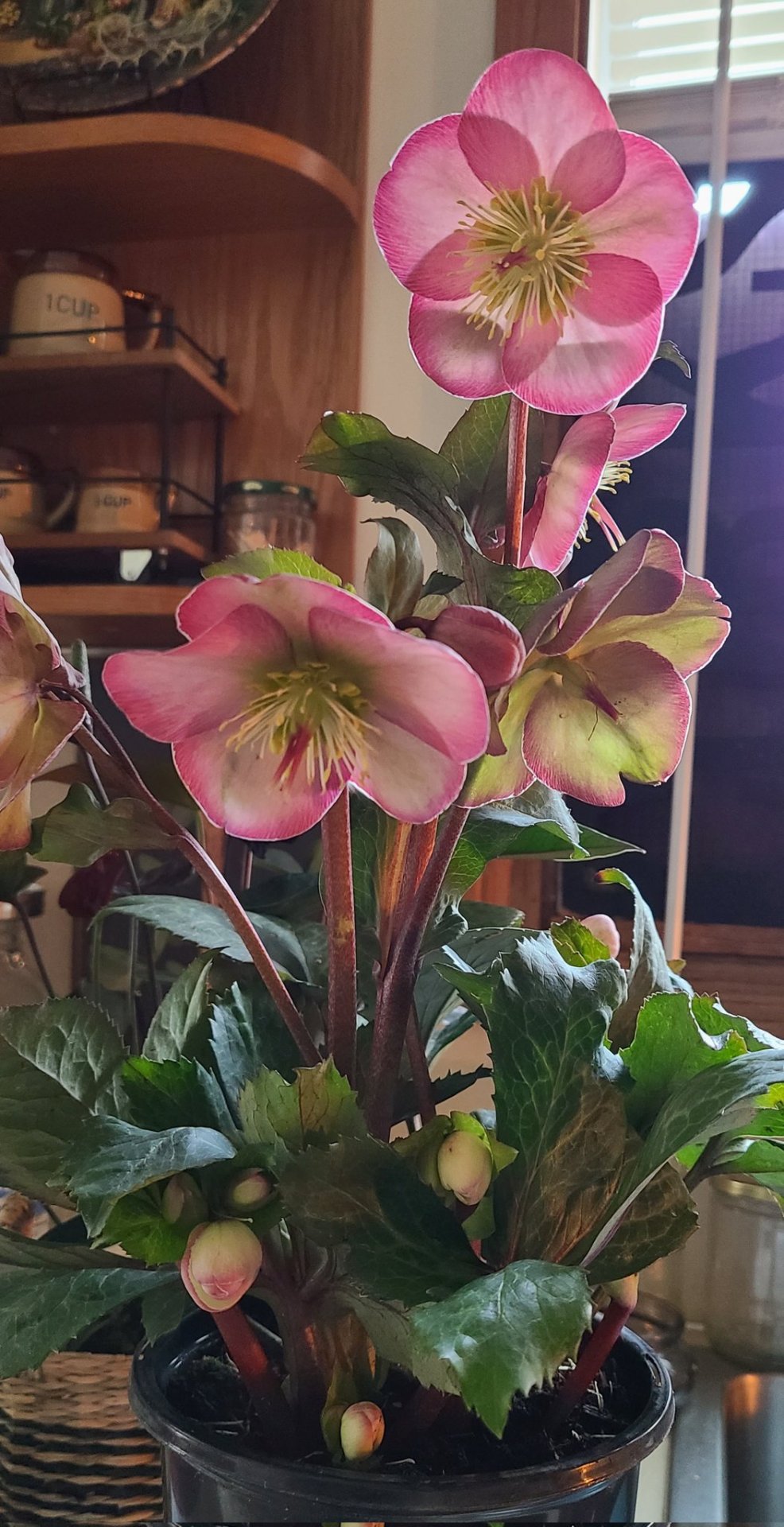
I. Am. Obsessed 🌸
#Hellebore#baneful magic#poison path#traditional witchcraft#folk witchcraft#folk witch#witch cunning#witchblr#witches of tumblr
64 notes
·
View notes
Text
Datura’s Daughter
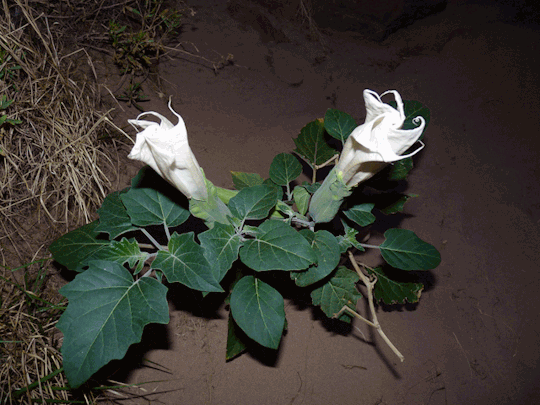
Reading Key 🔑
OPEN & LISTEN/READ ALL LINKS. THIS IS FOR UNDERSTANDING.
ALL LINKS ARE UNDERLINED RED
I had briefly read about Datura as a late teen/20-year-old. The plant intrigued me and was always in the background of my walk (studies). She wasn’t of utmost importance to me regardless of Her ever presence. I simply wasn’t ready...until I was.
My stumbling upon Datura in real life was serendipitous and so so unexpected.
August 2019, I was having a full moon stroll with a beloved musical genius. We will call him FireBird.
FireBird and I were discussing the Andromedin star system, and the Arch(acnid)s of Time. He and I tended to get deeply esoteric with each other. He kept up with me AND expounded upon conversation to the point where I found myself having to keep up with him. Despite the craziness of our connection, he and I were kin in that way. Hearts that sincerely sought to be One with Mystery.
Selene in Her fullness beamed down on us. Crickets sang their song, and East Atlanta’s humidity cloaked our skin.
We’d came across his neighbor’s house like we did a million times before, but I guess this night the neighbor’s Datura blooms were at peak ripeness just for us to see.
The flowers held their faces up towards the moon. Their sentient, Gramophone petals bellowing out Her intoxicatingly quiescent aroma. I gasped. Literally. In awe.
FireBird was off put, but I told him it was Sacred Datura, and he trusted my giddy response. Omg FireBird, I read about that plant before, see! Come on!
I innocently went over to the neighbor’s yard and inhaled with my whole lung. I picked a flower and nectar spilled over my fingertips. I eagerly put the flower in his face for him to inhale and experience Her as well.
I was ignorant that an inhale + nectar absorbed through skin alone will send you on a trip- though not nearly as deadly as ingesting the seed. Things got creepy, crawly, hilarious, scary, and <<*~FreaQQy~*>> (freaky::frequency), to say the least. An unplanned Datura encounter is an initiation in and of itself. This animalistic plant tends to stay with you. Your shadow is the humectant, and Datura is the moisture. I have learned that it is possible to come across certain plants and be inside their vortex…indefinitely.
Four years have passed, and I have been inside Datura’s Fib0nacci ever since- with less intensity as time goes on.
Here is some of what She’s revealed to me…
Vision Quest & Flying Ointment
Datura (Thorn Apple, Jimsonweed, etc.) belongs to the Solanaceae family- the same family as tomatoes, potatoes, and bell peppers. She is a weedy perennial, with large trumpet blooms, and stanky, menacing leaves. Solanaceae is unique in that several species contain the presence of strong alkaloids. Alkaloids are multifaceted organic plant compounds, and can be toxic to humans in even low amounts. Within Datura are three tropane alkaloids: atropine, hyoscyamine, scopolamine. Of the tropanes in Datura, hyoscyamine tends to have higher concentration; however, depending on the species + time & place of harvest, tropane concentration may vary. Datura’s alkaloids (as with all Solanas) effect the body in a host of ways, but the most common are pupil dilation; reduced secretions from respiratory, urinogenital, salivary, and other mucosal glands; effects on the sympathetic and parasympathetic nervous system; rapid increase or decrease in heart rate.
Datura is a deliriant under the hallucinogen umbrella. In the offshoots of reddit, one can find the r/Datura community where users describe their Datura horror stories. Deliriants (aka derailments) trigger erratic behaviors that can endanger others or self, strong hallucinations, hysteria, an inability to realize that one *is* hallucinating, vivid dreams, memory loss, true dysphoria, and more. Unfortunately for most...Datura’s hallucinations are that of a waking nightmare. Ain’t nothing cute and lighthearted about Her.
Despite Datura’s terrifying association, She has been recorded for medicinal and spiritual purposes amongst various groups throughout the world. I find, as with most toxins and venoms, that the cure is hidden within the poison. It is painfully clear that earlier generations were aware of this knowledge when compared to modern people’s haphazard use of Datura. It seems as though, for the same effects tropane alkaloids cause, they can also relieve them as well.
Datura (+ Her other tropane containing sister flowers) assist with: easing migraines, pain, & muscle spasms; curbing mucosal excess; rectifying cognitive problems stemming from spine injury; settling motion sickness & nausea; regulating cardiac arrythmia; unraveling violent PTSD and sexual traumas; and even calming asthmatic fits (when smoked). Speaking of smoke, ain’t it funny how Datura is in the same family as Tobacco? A common hallucination people report is that cigarettes appear out of thin air- and they have a smoke. Once they’re done smoking, the cigarette reappears again, and they are compelled to do it over again. Is it that during this hallucination, the body is attempting to regain control over respiratory function? Who knows...
According to Kymia Arts, fire neutralizes tropane alkaloids, and ol plant lady Emma Dupree states here (@ minute 13:13) that dried Datura leaves “help em get they breath.”
In homeopathic practices, specialists name those who could benefit from Datura as a Stramonium person. In extreme cases, this person has a deep fear of the dark, fear of danger, homicidal tendencies, an aversion to water, reflective surfaces, and being alone. They can be epileptic, manic, rageful, and schizophrenic. In mild cases, they can be dyslexic, have poor speech, or muscle ticks. I intuit that Datura heals these ailments because spiritually, this person is already in Her realm...and only She can reclaim & set you free. She allows one to overcome their fears by *leaving* it at Her doorstep. For She eats fear and all arcane things for dinner...
On the inverse, Datura intoxication causes extreme dry mouth/throat, extreme thirst, speaking in tongues/babble, auditory phantoms, incoherence, loss of motor function, inability to read, inability to *perceive* danger, and (hopefully) temporary madness...
As I said before, Datura has been used worldwide by a wide range of groups. According to Pharmako Gnosis, the Tsonga of South Africa “use Datura fatuosa in girls’ initiation ceremonies for exorcism. After the ingestion of a decoction of Datura root, the ceremony is marked by dancing, rapid drumming, disrobing, and the invocation of a blue-green pattern of the ancestor spirits” (p. 248).
One of Kalifornia’s indigenous tribe Chumash were known to use Datura ritualistically as well. For them, the main purpose of Datura consumption was to receive the gift of a dream helper. The Chumash chose the female Datura plant, dried Her root, and chewed the dried root during winter [Saturn’s season::Datura’s planetary ruler]. It is reported that their ceremonies with Datura were called Vision Quest (in Chumash Mother Tongue of course). One can even find the term Vision Quest in modern media; a prime example is in the suspense-horror film “Us” directed by Jordan Peele. There is a reoccurring scene where small girl is sent to a creepy mirror filled “funhouse” with the banner Vision Quest over the top. That “funhouse” is akin to a Datura trip...

In India, the powdered seeds were mixed with butter and taken internally for impotence as well as being applied to genitalia to obtain sexual vigor (Lewis 1977:330). Referred to as the tuft of Shiva, the god of destruction, Datura was also used in the form of a liquid extract by thugs - worshipers of Kali, the goddess of fertility and death - to stupefy sacrificial victims. The plant was also given to young girls in India to bring them Into prostitution as well as on their clients (Siegel 1989:21). The leaves were smoked as well in that country to relieve asthma (Lewis 1977:395).
Datura metel. Phytognosis.
In European traditions, plant women were known to create flying ointments containing Datura or another tropane containing Solanas. It is possible that the creation of flying ointments are a part of why women during that time were accusing of “flying on brooms.” It is said witches would apply flying ointments to their brooms, or even to their vuvlas for aphrodisiac effects.
“All of the tropane plants were major ingredients in various “flying ointments,” along with sundry other dangerous and nefarious substances such as water hemlock (Cicuta virosa), hemlock (Conium maculatum), monkshood (Aconitum napellus), opium poppy (Papver somniferum), soot, baby’s fat, bat’s blood and poplar (Populus spp.) Pharmako Gnosis. (245).
Another hallucination people have reported is a feeling of flying, or the sight of levitating beings. I attribute the flying sensation to an increase in heart rate. Interestingly, I have a hunch that users may also be experiencing the essence/spirit Datura’s primary polliantor, the nocturnal Sphinxmoth.
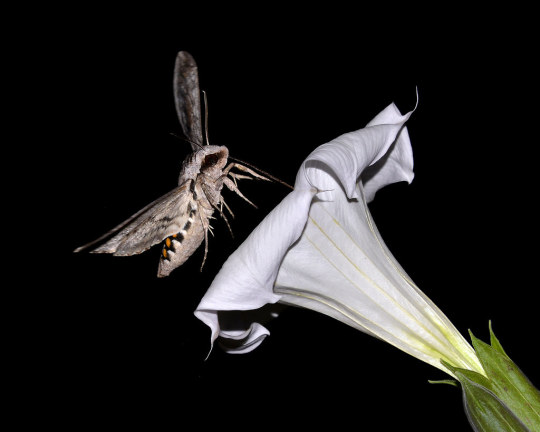
Now I want you to take the time to read this. Below is an instagram caption from artist and chemist Bryan Lehto of Bio Temple Hawaii.
This amino acid (Tropane) plays a critical role in a variety of biological processes, from the formation of bird feathers to the synthesis of tropane alkaloids and the production of polyamine spermidine. The presence of ornithine in nature is a reminder of the intricate connections.
Birds are perhaps the most well-known source of ornithine in nature. This amino acid is a critical component of the keratin that makes up bird feathers. Ornithine is an important precursor to the synthesis of the amino acid arginine, which is used to make the keratin that forms feathers. Without ornithine, birds would not be able to maintain their distinctive plumage and would be unable to fly or regulate their body temperature.
Interestingly, ornithine is also a precursor to the synthesis of tropane alkaloids. These are a class of organic compounds found in a variety of plants, including belladonna, henbane, and jimson weed (Datura). Tropane alkaloids are known for their psychoactive properties and have been used for medicinal and ritual purposes such as flying ointments for centuries. The presence of ornithine in these plants that underlie their pharmacological effects. Their poisonous berries are spread by birds.
Ornithine is a precursor to the synthesis of the polyamine spermidine. This compound is found in all living cells and plays a crucial role in a variety of cellular processes, including DNA replication, protein synthesis, and cell division. Spermidine is involved in the growth and development of plants, as well as the maturation of sperm cells in animals.
An intermediate in the biosynthetic pathways of both tropane alkaloids and spermidine are the compounds of putrescene and cadaverine, the odors of death.
If we look at the metaphors present in the biological processes of the amino acid ornithine, we see not only the metaphor of flight but the leitmotif of death, the underworld, and the resurrection of new life.”
Cool rite?
Let’s keep going...
Vampire Squid from Hell
When Datura (or any other powerful plant) takes you into its vortex, intel about its occulted aspects finds its way to you without overt searching. She made it clear soon after our encounter that She is a land-dwelling expression of a cephalopod named Vampyroteuthis Infernalis, or Vampire Squid from Hell. Vampyroteuthis Infernalis hasn’t had many extreme changes over the course of its 350-299 million year existence. It is considered a living relic, which means the genetic wisdom of this creature is still intact for us to observe and understand.
One can detect the energetics of Datura in the location, and physiology of Vampire Squid.
Vampire Squid dwells in the Mesopelagic Zone of the Ocean where oxygen becomes sparce. This deepening end of the Ocean is coined the oxygen minimum zone (OMZ). The Mesopelagic is also attributed the phenomena of twilight. Lingering sunlight wanes rapidly into darkness, and temperature sharply declines as depth increases. The lines between the surface waters and the abysmal deep begin to transition here. Let’s consider the Ocean’s surface, or Epipelagic Zone as Datura’s inviting flower, and the abysmal home of Vampyroteuthis (OMZ) as Datura’s Lethal Alkaloids. Dawn. Dusk. Twilight.

Organisms that live in this level begin to display bioluminescence. Their eyes & physical form take on an…alien, strange appearance.

Vampire Squid reportedly has the largest eyes in the animal kingdom, an adaptation needed to capture any glimpse of light in the endless black seas. It’s 8 arms are webbed and tipped with bioluminescent photophores. The underside of its webbing is decorated with fleshy spikes. When irritated, Vampire Squid will cloak itself in its arms, exposing these spikes. It not only takes on the shape of Datura’s inflorescence, but also Datura’s radical seed pod.


[Photo Credit: Pinterest; Bing Images]
This blue-blooded cephalopod lives primarily in a resting state. Due to such low oxygen levels, it must maintain a low metabolism to conserve energy, and even possesses certain enzymes associated with anaerobic metabolism. The likelihood of Vampire Squid coming across live prey is rare- and so it feasts on detritus (decay, feces, mucus, “marine snow”) that sink from the Ocean’s surface.
When reading about Vampire Squid, one fact that stood out to me is that they have “weak musculature but maintain agility and buoyancy (in the OMZ) with little effort due to sophisticated statocysts (balancing organs akin to a human's inner ear)(Wikipedia). Recall Datura’s aforementioned Gramophone petals? And Vampire Squid’s webbed arms? Don’t they look like triplets? What’s the connection?
Here are some field notes:
Oxygen Minimum Zone::OMZ::Ohms::Ω::OM:: H0me:: The Highly Contagious Viral Realm of Shadows:: Consequence of Datura’s toxic alkaloid scopolamine that causes respiratory failure [OXYGEN IS SPARCE]. Alchemist Kymia Arts states that the plant can cause one to suffocate themselves, as they drift off unconsciously into delirium. You won’t realize you’re drowning.
Gramophone::Grandma Phone::Recordings of the Crone [Saturn; ruling plant of Datura]. Hell’s Record Keeper.
Download:: Datura somehow has a mechanism on the human inner ear (statocyst, Vampire Squid buoyancy) causing auditory hallucinations… the intoxicated victim is finally able to hear the sounds of their own inner hell. Their internal Oxygen Minimum Zone.
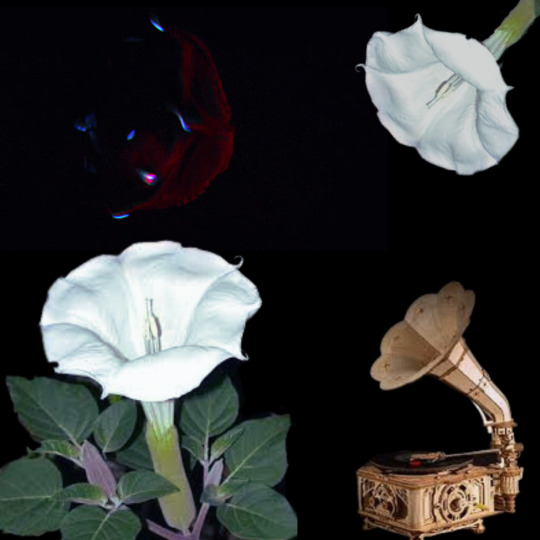
Datura’s Daughter Short Materia Medica
Planetary Ruler: Saturn, Venus, and Mars
Energetics: Extremely Drying & Bitter; Drying action Causes Heat
Z0diac: Capricorn, Scorpio, Libra
Organ Systems: Sympathetic & Parasympathetic Nerves, Respiratory, Cardiovascular, Neuromuscular, Urinogenital
Properties: Deliriant, Hallucinogen, Shamanic, Poison, Anodyne, Antispasmodic
Associations: Death, Rot, Blood, The Devil, Decay, Madness, Hysteria, Fear, Trauma, OMZ, Gramophone, Vampyroteuthis Infernalis, Flight, Levitation, Sphinx Moths, Animalistic Urges, Indigenous, Folklore Traditions, Thugges of India (Datura shows who Thugs *really* are), Queen Toloache, Alice in Wonderland Queen of Hearts, Smoking, Lord Shiva, Chumash (California Condors), Initiatory Practices of men & the young.
WARNING: Datura no longer respects or trusts 99.9% of humans. This is why so many Datura abusers don’t learn any lessons from Her as they would Psilocybin. Approach Datura with the utmost respect, sincerity, and innocence and you *might* be spared...
One night, a long time since that East Atlanta evening, I was tending to my garden. I had my playlist on shuffle. The song Throw Yo Sets in Da Air by Three 6 Mafia came on. I peeped my little Jimsonweed Datura dancing to it, specifically to the first verse given to us by the late Gangsta Boo, the Devil’s Daughter, and my inspiration for Datura’s Daughter. She gave me a wink and said She liked that verse! Haha. And so, from that day, Gangsta Boo’s verse has become what I call Datura’s Chanting Prayer. Linked below.
RIP Gangsta Boo
The Devil’s Daughter::Datura’s Daughter Chant Prayer
I think I finally have located the Gates of Death
Lie awake at Night to hatch my Evil plots I find Myself
Stumbling thru the Dark up against the f*ckin Verge of Sins
Bodies in my yard- Oh My God the Demons came again
People don’t you worry cus Datura’s Daughter got a plan
Ho, eternal burning you will have if you don’t comprehend
Understand this sh*t a Gangsta Bitch is sayin to ya Dawg
Lock you in the trunk mob thru the Night within a Mist of Fog
Never Fear a Nigga callin himself a Killer- wassup Bitch?
Boy you claim you so gahdamn Buck Wild wit that weak ass sh*t
Chillin at the hideout, smokin out, not worried bout a thang
Ballin through Black Haven deep as hell in that Suburban mane
Always watchin my back cus Niggas will jack you for your f*ckin sh*t
Female I am but don’t give a damn if I split some bustas bitch’s wig
Three 6 Mafia Niggas including one Female that’s bumping so Hard on you hoes
The only one talking that shit is these jealous ass niggas && all playa hatas you kno...

DISCLAIMER: I do not promote or recommend ingesting Datura AT ALL. Datura CAN and WILL kill you. Datura can cause PERMANENT psychosis/schizophrenia, blindness, and damage to the heart, liver, and kidneys. If ingested/applied topically, it must be done with the assistance an EXPERIENCED plant professional in THERAPEUTIC DOSES ONLY. Therapeutic doses are EXTREMELY diluted or combined with other alkaloid balancing compounds.
DO NOT INGEST DATURA. She is not a psychedelic. She is a DELIRANT in even moderate doses. For experiences similar to mine, sincere and respectful communing with a live Datura plant is all that is necessary. You can still be impacted (spiritually) by Datura without taking that risk...
DO NOT work with Datura if you are not ready to mature and deal with the recesses of your unconscious mind, the places you don’t touch...where oxygen is low...and detritus is nourishment.
#Datura#Shamanism#Herbalism#Botany#Marine Biology#Biological storytelling#my words#Ma'ateria Meda#Secret Life of Plants#entheogens#occult#plant medicine#poison path
33 notes
·
View notes
Text

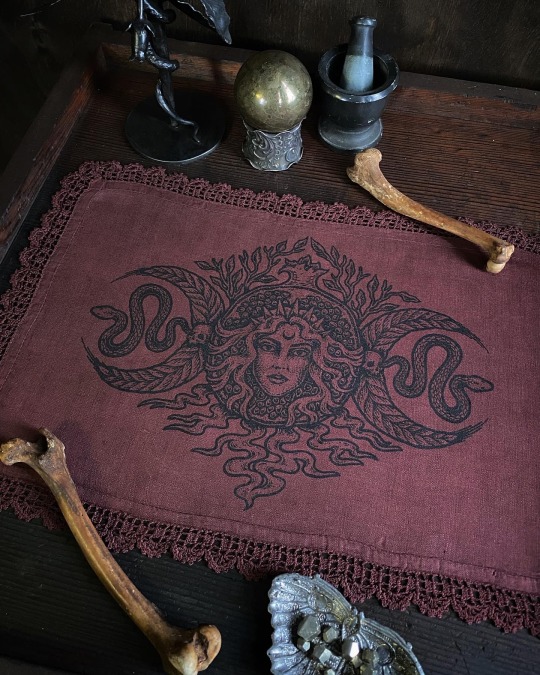

The Studio Clean-out is all set for this Sunday, March 12th @ 9pm ET! You can expect to see 2nds of all kinds, one-of-a-kind altar cloths, and select discounts on prints, t-shirts, bandanas, stationery, & more.
In addition, this week I’ll be announcing a few prints that are being discontinued so keep your eyes peeled!
PoisonApplePrintshop.com
#poisonappleprintshop#studio sale#spring sale#altar cloth#witch#altar#poison path#Persephone#witchy#decor#witchcraft#datura#Artemis#goddess
91 notes
·
View notes
Text
Belladonna Devotional Earrings (Sold Out)
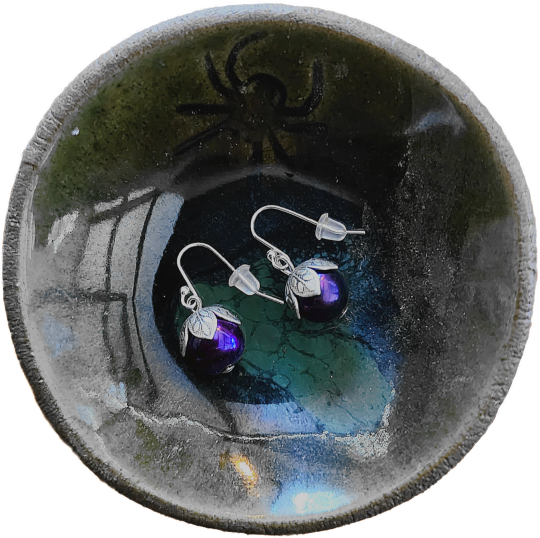

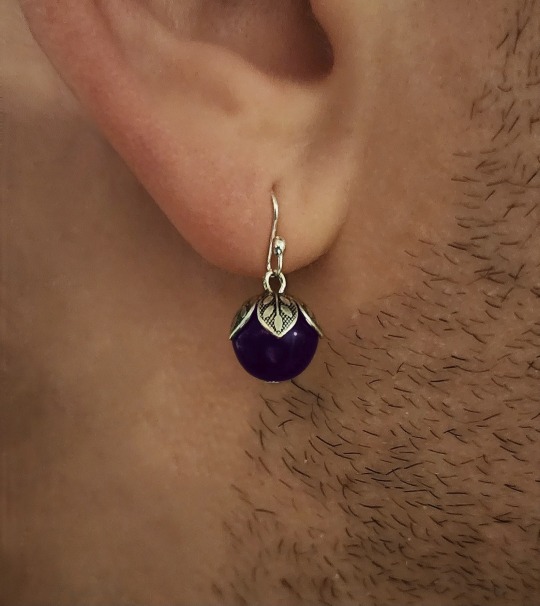
On a whim , I decided to make and sell a couple pairs of Belladonna Devotional Earrings.
They were crafted in the likeness of Belladonna Berries using natural violet Pearls, silver-plated pewter bead-caps, and fine-silver wire hooks. They were, likewise, consecrated to the spirit of Poison Nightshade in a ritual where they were anointed with the juice of its berries and fumigated with the smoke of its burned flowers.
If interested in acquiring a pair, simply reach out here, or visit my webshop to purchase them directly!
#belladonna#poison nightshade#belladonna berries#devotional earrings#poison path earrings#poison path#poison path jewelery#devotional jewelry#wending wares#witch earrings#witch jewelry
47 notes
·
View notes
Text
Prayer to Datura
Flower of flowers, God among gods.
I, too, night-Bloom.
I hide away my perfume
From the prying eye of day.
I, too, hold secrets that glow
Teach me how to open to those that can know
Teach me to hold fragile things with care
Teach me to grow and to die
Let me drop my spent pieces to the Earth.
Let me breathe new air.
8 notes
·
View notes